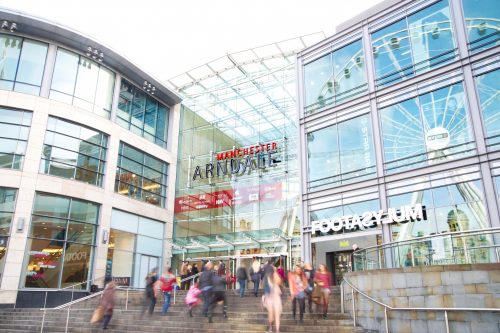High streets – down but not out

The high street is under pressure like never before. The number of empty shops in UK town centres has reached its highest level since 2015.
Retail is widely seen as an ailing sector, struggling to capture custom that has migrated online. There’s also the challenge of out of town shopping and the growing pull of the big cities.
Little wonder there are some doomsday predictions of derelict and abandoned shopping areas as more stores bring down the shutters down.
However there are encouraging signs of a fightback. Altrincham is a prime example of a town centre that refuses to lie down – adapting and re-inventing itself to meet the challenges it faces.
Altrincham town centre’s revival and regeneration has been hailed nationally and internationally. It was named the best high street in England last year.
And the market town was also chosen to trial the ‘National High Street Perfect Day’ earlier this year.
It follows the government’s ‘High Street Report’ chaired by Sir John Timpson, which recommended that local leaders must be at the forefront of the rejuvenation of town centres and improving the housekeeping of their high streets.
Sir John declared: “It’s a town where the partnerships are working really hard in a challenging national high street environment to buck the trend.”
It’s all a far cry from 2010 when Altrincham was labelled Britain’s” biggest ghost-town” after it was revealed that it had the worst shop vacancy rate in the UK, with more than 30 per cent of stores sitting empty.
Altrincham’s challenges included the fact that the giant Trafford Centre was just seven miles away.
So what has changed? The redevelopment and re-invention of Altrincham Market has been hailed as one of the catalysts for change.
Transformed into a new leisure and eating-out venue, today it attracts ‘foodies’ from across the North West.
A partnership approach is also paying dividends. Altrincham’s town centre BID, which works on behalf of around 540 businesses, continues to play a big role.
Its business development manager Elizabeth Faulkner says: “Back in 2010 the community came together. No-one could believe that a town like Altrincham could have headlines like ‘ghost town’.
“The regeneration was not down to one particular organisation or body. It was the private and public sector and the community all coming together in partnership.
The transformation of Altrincham Market was a major stepping stone, with the investment in a quality food and drink offering. It put the heart back in town and created the destination.”
That destination continues to attract. Faulkner says town centre football is up 5.8 per cent on last year. She compares that to a 3.4 per cent fall experienced by the UK’s market towns.
Faulkner describes Altrincham as a “modern market town” and says that investment in the public realm and the transport interchange also played their part. She says: “As footfall into the town increased businesses started to invest.”
The high street has also evolved. As well as a new cinema and restaurants there are businesses offering sewing and pottery classes and gyms.
Faulkner says: “It is about offering experiences that you can’t buy online. The evening economy is changing as well and the community is enjoying the town centre in ways that it never used to.”
She adds: “It’s not just the retailers; professional services are playing their part. It’s about everyone coming together.
“If we’ve learned one lesson it is that no-one can do this on their own. Everyone needs to come together to create a powerful force for change.”
Altrincham isn’t the only North West town that has undergone a high street transformation.
Hoylake, on Wirral, is also working hard to restore it fortunes and has won multi-million pound funding to make its community vision reality.
The town has received a £3.64m government grant to create an ‘arts village’ – with a two-screen cinema, a high end restaurant, a bar and a café bistro, as well as 18 creative studio and retail spaces for artists and makers around a central courtyard.
Upper floors of the development will be converted into 40 apartments using private funding.
Those behind The Beacon Arts Village project, Hoylake Village Life CIC and site owners Hylgar Properties, believe it will help reimagine the town’s high street.
The building, first opened for use in 1898, is currently home to the monthly ‘pop-up’ Hoylake Community Cinema, as well as a number of small creative enterprises.
The grant is from the Coastal Communities Fund, designed to help coastal communities flourish and strengthen their appeal.
Mark Howard, Hoylake Village Life volunteer and founder of the community cinema, says: “To stay alive, a town needs to keep up a process of continual change and sustainable redevelopment and this project is an exemplar of that.
“Hoylake has a burgeoning reputation as a cultural hub and we believe that the arts is the key to the on-going sustainable regeneration of the town.”
Changing times
Andrew Astin, associate director at planning consultancy WSP Indigo, says there is growing evidence that the high street is evolving in the North West. However, he believes more support is needed to ensure its future health.
Astin says: “Town centres and high streets in the North West have historically been shopping destinations, yet due to a number of national retailers closing stores in town centres, these are becoming increasingly popular for entertainment and leisure activities, such as restaurants and bars, the theatre or beauty and hair salons.
“We are also seeing more residential uses in town centres, and such a diversity of uses makes an important contribution to the vitality and viability of town centres, in particular increasing footfall in the evening.”
He adds: “The government has attempted to support the vitality of the high street through the introduction of new permitted development rights enabling the change of use of buildings without planning permission, in certain circumstances, and by providing additional funding to help to improve town centres.
“These measures are clearly needed; however they do not go far enough. They could be further assisted by allowing greater flexibility in the use of high street buildings if town centres are going to survive and thrive.
“This could include allowing more non-retail uses in primary shopping frontages which councils have historically sought to restrict, as well as introducing flexible use planning permissions which would allow a property to switch uses without the need to reapply for planning permission.
“Councils should also look at reducing town centre boundaries as defined in their Local Plans given some of these include peripheral areas no longer considered to form part of the town centres, and which could be redeveloped for alternative uses such as housing.”
Astin goes on: “The future high street will include more non-retail uses and become more of a mixed retail, leisure, cultural and entertainment destination. We will likely see more leisure, health and residential uses in town centres which will help to increase footfall and reduce the number of vacant units.”









